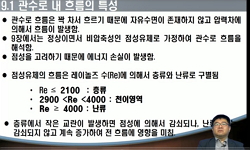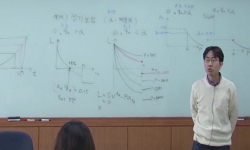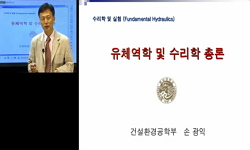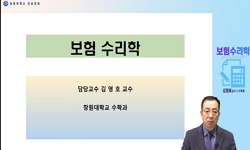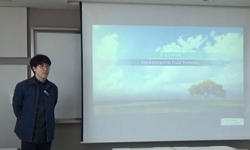ABSTRACT Hybrid-silica based biomimetic novel polyethersulfone (PES) membranes for robust anti-fouling and anti-wetting performance in direct contact membrane distillation (DCMD) Aftab Ahmad Khan Department of Civil and Environmental Engineering Grad...
http://chineseinput.net/에서 pinyin(병음)방식으로 중국어를 변환할 수 있습니다.
변환된 중국어를 복사하여 사용하시면 됩니다.
- 中文 을 입력하시려면 zhongwen을 입력하시고 space를누르시면됩니다.
- 北京 을 입력하시려면 beijing을 입력하시고 space를 누르시면 됩니다.
Hybrid-silica based biomimetic novel polyethersulfone (PES) membranes for robust anti-fouling and anti-wetting performance in direct contact membrane distillation (DCMD)
한글로보기부가정보
다국어 초록 (Multilingual Abstract)
ABSTRACT
Hybrid-silica based biomimetic novel polyethersulfone (PES) membranes for robust anti-fouling and anti-wetting performance in direct contact membrane distillation (DCMD)
Aftab Ahmad Khan
Department of Civil and Environmental Engineering
Graduate school of Hanyang University
Direct contact membrane distillation (DCMD) is a promising alternate technology for the treatment of highly saline, organic, seawater, oily wastewater, and industrial wastewater with theoretically 100% rejection. Nevertheless, its hindered to commercialize in large scale due to the fouling and wetting issue during operation. To counter the issue, preparing the MD membranes with anti–fouling and anti–wetting properties are inevitable. The rougher top surfaces and low surface energy robust membranes with no severe fouling and wetting, are highly recommended for the competent rejection of hyper saline organic solutions through membrane distillation (MD). Regarding this chapter 4 enlightens a hybrid organic-inorganic functionalized polyethersulfone (PES) membrane preparation for treating hyper-saline feed solutions containing humic acid (HA) foulant. The membrane modification was carried out by dip-coating with silica nanoparticles, followed by vacuum filtration coating with 1H,1H,2H,2H-perfluorodecyl triethoxysilane and polydimethylsiloxane. The PDMS-FAS/SiNPs membrane performance was respectively better from that of commercial polypropylene (PP) and polyvinylidene fluoride (PVDF) membranes. In the DCMD of a feed solution of 1 M NaCl and 10 mg L-1 HA, the flux of the PDMS-FAS/SiNPs membrane remained consistent (17 LMH), with a permeate conductivity of 33.96 µS cm-1.
In Chapter 5, a robust anti-wetting and anti-fouling PES membrane for the rejection of a highly saline (NaCl and CaCl2·2H2O) feed solution containing humic acid (HA) in DCMD. Response surface methodology (RSM) was used to determine the optimum formulation of the used materials. The variable factors selected were polydimethyl siloxane (PDMS) and silica (SiO2); liquid entry pressure (LEP) and contact angle (CA) were selected as responses. The optimum PES-13 membrane exhibited consistent flux of 12 LMH and salt rejection (> 99%) with anti-fouling characteristic in DCMD using the feed solution of 3.5 wt% NaCl+10mM CaCl2·2H2O +10mgL−1 HA.
Our third research in Chapter 6 describes the preparation of an anti–oil-fouling polyethersulfone membrane using fluorinated silica nanoparticles (F-SiO2@PES) combined with perfluorodecyl triethoxysilane and polydimethylsiloxane for application against oil/water emulsions. Feed solutions consist of different concentrations of oil (hexadecane), different charge surfactants (anionic sodium dodecyl benzenesulfonate, non-ionic Tween 20, and cationic hexadecyltrimethylammonium bromide, and salt (NaCl). No severe fouling was observed during DCMD process regardless of surfactant charge and the concentration of components.
The study in the chapter 7, was accomplished with the membrane similar to the previous study (omniphobic membrane). The modified PES membrane (PES-M) wetting and fouling resistance competence was assessed using two hypersaline feed solutions i.e., (I) multiple salts [2000 mg L-1 (CaSO4 + CaCO3 + CaCl2 . 2H2O + NaCl)] + 20 mg L-1 HA feed (MSHA-F) and (II) Busan seawater feed (BSW-F) in DCMD. The PES-M membrane exhibited the robust performance against both feeds especially with MSHA-F for 150 h long operation giving only 20% flux loss, and 68.8 μS/cm conductivity at the end. PES-M membrane is resilient candidate to resist fouling and wetting and suggested to adopt for the desalination of highly saline and complex feed solutions.
목차 (Table of Contents)
- Table of contents i
- List of Figures vii
- List of Tables xv
- ABSTRACT xvii
- Graphical abstract xx
- Table of contents i
- List of Figures vii
- List of Tables xv
- ABSTRACT xvii
- Graphical abstract xx
- Chapter 1 Introduction and objectives 1
- 1.1 Introduction 1
- 1.2 RO limitations 6
- 1.3 Membrane distillation (MD) for desalination 7
- 1.4 Membrane modification for MD 10
- 1.4.1 SiO2 for membrane modification 10
- 1.5 Research objectives 11
- Chapter 2 Literature review 15
- 2.1 introduction 15
- 2.2 Membrane distillation (MD): principles and mechanisms 16
- 2.3 Commercial membranes application in MD 26
- 2.4 Membrane material and microstructure for MD 26
- 2.4.1 membrane material 26
- 2.4.2 Thermal conductivity of membrane 29
- 2.4.3 Liquid entry pressure (LEP) and membrane porosity 30
- 2.4.4 Membrane surface properties 31
- 2.5 Fouling and wetting in MD 33
- 2.5.1 Fouling in MD 33
- 2.5.2 Wetting in MD 33
- 2.5.3 Factor affecting the fouling and wetting in MD 36
- 2.5.3.1 Effect of foulant and feed characteristics on fouling and wetting in MD 36
- 2.5.3.2 Effect of Membrane properties on fouling and wetting in MD 39
- 2.5.3.3 Operational conditions 42
- 2.5.4 Mitigation methods of fouling and wetting in MD 44
- 2.5.4.1 Pre-treatment of feed sample 44
- 2.5.4.2 Optimization of module configuration 51
- 2.5.4.3 Hybridizing/integrating MD application 53
- 2.5.4.4 Membrane fabrication and surface enhancement 54
- Chapter 3 Membrane fabrication and modification for fouling and wetting control in MD 58
- 3.1 Membrane fabrication/modificaton for MD 58
- 3.1.1 Nanomaterials (NMs) application for MD membranes 58
- 3.1.1.1 Carbon nanotubes (CNTs) based membranes 59
- 3.1.1.2 Graphen/graphene oxide (GO) based membranes 71
- 3.1.1.3 Quantum dots (QDs) based membranes 72
- 3.1.1.4 Metal organic frameworks (MOFs) based membranes 72
- 3.1.1.5 Zeolite based membranes 74
- 3.1.1.6 Metal/Metal oxide and metalloids based membranes 75
- 3.1.2 Challenges and future outlook for NMs based MD membranes 79
- 3.2 Novel MD membranes 85
- 3.2.1 Superhydrophobic membrane 85
- 3.2.2 Amphiphobic membrane 88
- 3.2.3 Omniphobic membrane 88
- 90
- 3.2.4 Composite membrane 91
- 3.2.5 Janus membrane 93
- Chapter 4 Hybrid organic-inorganic functionalized polyethersulfone membrane for hyper-saline feed with humic acid in direct contact membrane distillation 95
- 4.1 Introduction 95
- 4.2 Experimental section 97
- 4.2.1 Materials and chemicals 97
- 4.2.2 Surface modification of PES membrane 97
- 4.2.3 Optimization of coating material 100
- 4.2.4 Membrane morphology and surface studies 100
- 4.2.5 Stability tests 102
- 4.2.6 Wettability studies 102
- 4.2.7 DCMD setup 103
- 4.3 Results and discussion 106
- 4.3.1 Characterization of membrane surface 106
- 4.3.1.1 FESEM 106
- 4.3.1.2 Surface roughness 111
- 4.3.1.3 FTIR analysis 111
- 4.3.2 Stability tests 115
- 4.3.2.1 Thermal stability 115
- 4.3.2.2 Chemical stability 115
- 4.3.3 Analysis of membrane wettability 119
- 4.3.3.1 CA analysis 121
- 4.3.3.2 Static liquid entry pressure 121
- 4.3.4 DCDM evaluation 126
- 4.3.4.1 Effect of 1 M NaCl solution 126
- 4.3.4.2 Effect of combined NaCl and HA solution 129
- 4.4 Conclusions 132
- Chapter 5 Optimization of membrane modification using SiO2 for robust anti-fouling performance with calcium-humic acid feed in membrane distillation 134
- 5.1 Introduction 134
- 5.2 Materials and chemicals 136
- 5.2.1 Materials 136
- 5.2.2 Membrane modification 137
- 5.2.2.1 Preparation of coating solutions 137
- 5.2.2.2 Coating methodology 137
- 5.2.3 Design of experiments 138
- 5.2.4 Characterization of membranes 138
- 5.2.5 Wetting analysis 142
- 5.2.6 DCMD test 143
- 5.3 Results and discussion 143
- 5.3.1 Design of experiments 143
- 5.3.2 Analysis of variance 147
- 5.3.2.1 Effect of variable concentration on LEP 147
- 5.3.2.2 Effect of variable concentration on CA 152
- 5.3.3 Membrane surface and morphology 156
- 5.3.4 DCMD evaluation 161
- 5.3.4.1 Effect of F1 solution 164
- 5.3.4.2 Effect of F2 solution 167
- 5.3.4.3 Effect of F3 solution 167
- 5.4 Conclusions 171
- Chapter 6 Fluorinated silica–modified anti–oil-fouling omniphobic F–SiO2@ PES robust membrane for multiple foulants feed in membrane distillation 173
- 6.1 Introduction 173
- 6.2 Material and methods 176
- 6.2.1 Membrane and chemicals 176
- 6.2.2 Preparation of coating-solution for membrane modification 176
- 6.2.2.1 SiO2 fluorination 176
- 6.2.2.2 Solution and membrane-coating procedure 177
- 6.2.3 Membrane characterization and feed evaluation 179
- 6.2.4 Membrane distillation setup 182
- 6.3 Results and discussions 183
- 6.3.1 Surface characterization and wettability of membranes 183
- 6.3.1.1 FESEM and EDS analysis 183
- 6.3.1.2 Atomic force microscopy 186
- 6.3.1.3 FTIR analysis 190
- 6.3.1.4 Surface tension effect on CA and LEP 190
- 6.3.1.5 Zeta potential and oil droplet size 194
- 6.3.2 Membrane distillation operations 194
- 6.3.2.1 Feed temperature and flow-rate optimization 195
- 6.3.2.2 Effect of various combinations of feed components 198
- 6.3.2.3 Effects of varying concentrations of feed components 200
- 6.3.2.4 Effect of surfactant type and concentration increase 203
- 6.4 Conclusions 206
- Chapter 7 Anti–fouling slippery membrane surface engineered for long–term operation with hypersaline synthetic and Busan seawater feeds in membrane distillation 209
- 7.1 Introduction 209
- 7.2 Material and methods 212
- 7.2.1 Material 212
- 7.2.2 Surface enhancement of membrane 212
- 7.2.3 Membrane characteristics and surface studies 212
- 7.2.4 Direct–contact membrane distillation and membrane cleaning 215
- 7.3 Results and discussion 217
- 7.3.1 Membrane structure and surface characterization 217
- 7.3.1.1 Surface and morphology studies 217
- 7.3.1.2 Pore size distribution and porosity 223
- 7.3.2 Wettability of membranes 229
- 7.3.3 DCMD performance 232
- 7.3.3.1 Effect of different characteristics feed solutions 232
- 7.3.3.2 Membrane reusability assessment in long-term operation 236
- 7.4 Conclusions 242
- Chapter 8 Summary and conclusions 245
- References ………………………………………………………………………… 250






